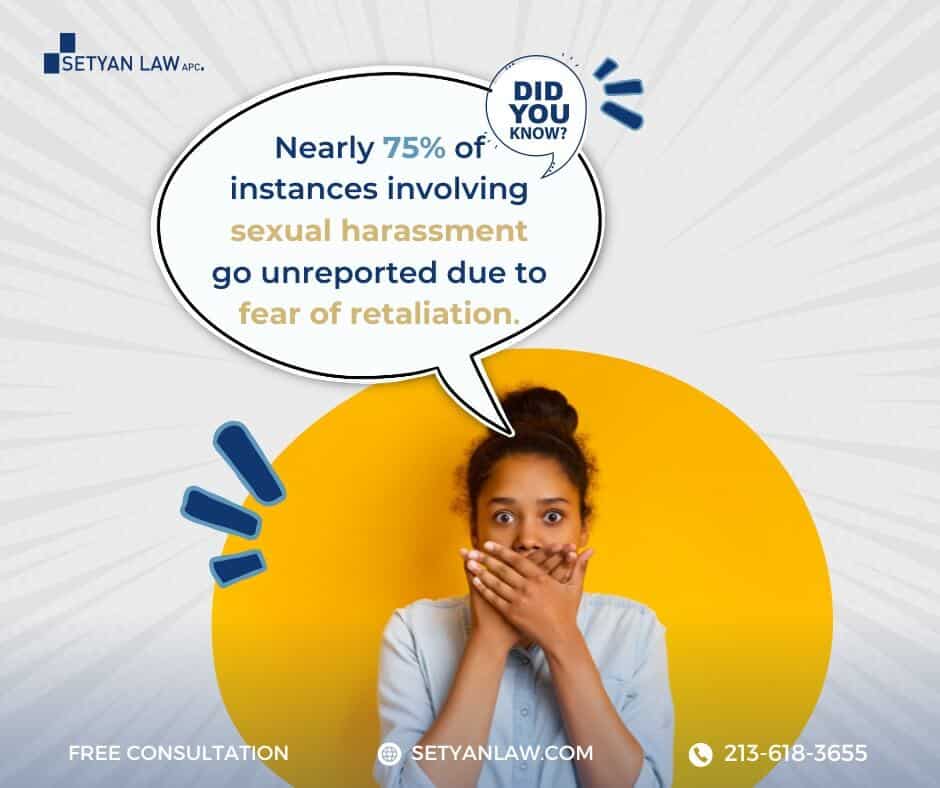Updated October 20, 2025
Understanding Sexual Misconduct: Crucial Differences
Despite increased awareness and education, sexual misconduct remains a pervasive issue in our society. Understanding the distinctions between different types of sexual misconduct is essential for recognizing, preventing, and addressing these behaviors effectively. California law provides specific frameworks for handling various forms of sexual misconduct, with important distinctions between sexual harassment, sexual assault, and other related offenses.
Sexual misconduct encompasses a range of unwanted behaviors of a sexual nature. By understanding these differences, individuals can better protect themselves and others, while also knowing their legal rights and options when violations occur. This knowledge is particularly important given that approximately 30% of women aged 15 or older report experiencing sexual assault at least once in their lifetime.
Sexual violence affects people of all backgrounds, though women, girls, and gender-diverse individuals face disproportionately higher risks. The impacts of such experiences can be profound and long-lasting, affecting mental health, relationships, and overall quality of life. Recognizing the signs and understanding the legal frameworks is the first step toward addressing this serious societal issue.
Defining Sexual Harassment
Sexual harassment refers to unwelcome conduct of a sexual nature that creates an intimidating, hostile, or offensive environment. Under California law, sexual harassment encompasses a broad spectrum of behaviors that may not necessarily involve physical contact. This form of misconduct often occurs in professional settings like workplaces or educational institutions, though it can happen anywhere.
Sexual harassment typically falls into two main categories. The first is quid pro quo harassment, where someone in a position of authority demands sexual favors in exchange for benefits like promotions, favorable grades, or other advantages. This abuse of power dynamics is particularly insidious as it exploits vulnerability and dependency relationships.
The second category is hostile environment harassment, which involves unwelcome sexual comments, jokes, images, or behaviors that create an intimidating or offensive atmosphere. This might include displaying inappropriate images, making suggestive remarks, sending unwanted messages of a sexual nature, or engaging in other conduct that interferes with an individual’s ability to function comfortably in their environment.
According to research, approximately 52% of women in Canada have experienced sexual harassment in their workplace. The prevalence of this issue highlights the importance of clear policies and legal frameworks to address and prevent such behaviors. California law provides specific protections against sexual harassment, recognizing its serious impact on individuals’ well-being and professional development.
It’s important to note that sexual harassment doesn’t always involve explicit sexual advances. It can also include gender-based harassment, such as derogatory comments about someone’s gender identity or expression. The key factor is that the behavior is unwelcome and creates a hostile or uncomfortable environment for the recipient.
Understanding Sexual Assault
Sexual assault refers specifically to unwanted physical sexual contact that occurs without consent. Unlike sexual harassment, which may be verbal or environmental, sexual assault always involves physical contact of a sexual nature. California law treats sexual assault as a serious criminal offense, with penalties that can include imprisonment, fines, and registration as a sex offender.
Sexual assault encompasses a range of physical acts, including unwanted touching, groping, kissing, or fondling. The defining characteristic is the lack of consent – the victim has not freely agreed to participate in the sexual activity. It’s crucial to understand that consent cannot be given if a person is unconscious, intoxicated, under duress, or otherwise incapacitated.
The impact of sexual assault can be profound and long-lasting. Survivors often experience psychological trauma, including post-traumatic stress disorder (PTSD), depression, anxiety, and difficulties with trust and relationships. The legal system recognizes these serious consequences, which is why California law provides specific frameworks for addressing sexual assault cases.
Statistics indicate that sexual assault remains significantly underreported, with only about 6% of incidents being reported to police. This underreporting stems from various factors, including fear of not being believed, shame, embarrassment, and concerns about the legal process. Understanding the legal definitions and protections can help survivors make informed decisions about reporting and seeking support.
It’s worth noting that sexual assault can occur between strangers, acquaintances, friends, or intimate partners. The relationship between the individuals does not negate the requirement for consent, and California law recognizes sexual assault regardless of the relationship between the perpetrator and the victim.
Rape: A Specific Form of Sexual Assault
Rape is a specific type of sexual assault that involves penetration without consent. Under California law, rape is defined as non-consensual sexual intercourse accomplished through force, fraud, or coercion. This serious crime carries severe legal penalties, including lengthy prison sentences and lifetime sex offender registration requirements.
The legal definition of rape focuses on penetration, regardless of how slight, of any body part or object into the genital or anal opening of another person without their consent. This can include vaginal, anal, or oral penetration with a body part or object. The absence of consent is the critical element that defines rape, regardless of the relationship between the individuals involved.
Contrary to common misconceptions, rape is not limited to situations involving physical violence or resistance. California law recognizes that rape can occur through coercion, threats, manipulation, or when the victim is incapable of giving consent due to intoxication, unconsciousness, or mental incapacity. This broader understanding reflects the reality that many sexual assaults do not involve overt physical force.
Statistics reveal that in the majority of rape cases, the perpetrator is known to the victim. This reality contradicts the common stereotype of rape being committed primarily by strangers. Friends, acquaintances, and neighbors represent approximately 52% of sexual assault perpetrators, highlighting the complex nature of these crimes and the breach of trust they often involve.
The psychological impact of rape can be particularly severe and long-lasting. Survivors may experience PTSD, depression, anxiety, sleep disorders, and difficulties with intimate relationships. California law acknowledges these profound impacts through its approach to sentencing and victim support services.
Sexual Abuse: Focus on Vulnerable Populations
Sexual abuse refers to sexual misconduct directed at particularly vulnerable individuals, especially children. In California law, sexual abuse of minors is treated with particular severity, recognizing that children cannot legally consent to sexual activities. The age of consent in California is 18, and any sexual activity with someone under this age may constitute statutory rape or other sexual offenses.
Sexual abuse encompasses a wide range of behaviors, from inappropriate touching to forcing a child to view pornographic material or engage in sexual acts. The law recognizes that children are particularly vulnerable to manipulation and coercion, and therefore provides enhanced protections and penalties for offenses involving minors.
While the term "sexual abuse" is often associated with children, it’s important to recognize that adults can also experience ongoing sexual abuse, particularly in the context of domestic violence or other power-imbalanced relationships. California law provides protections for all victims of sexual abuse, regardless of age, though the specific legal frameworks may differ.
The impact of childhood sexual abuse can be particularly profound and long-lasting. Research indicates that survivors of childhood sexual abuse are at higher risk for developing mental health issues, substance abuse problems, and suicidal behaviors later in life. The legal system recognizes these serious consequences through enhanced penalties for offenders and specialized support services for survivors.
Prevention of sexual abuse requires community awareness and vigilance. Recognizing the warning signs of potential abuse and understanding reporting obligations are crucial steps in protecting vulnerable individuals. California law mandates that certain professionals, including teachers, healthcare providers, and social workers, report suspected child abuse to appropriate authorities.
Consent: The Critical Element
Consent is the cornerstone of distinguishing between lawful sexual activity and sexual misconduct. Under California law, consent must be affirmative, conscious, and voluntary. It is an enthusiastic and ongoing agreement to engage in sexual activity, which can be withdrawn at any time. Understanding consent is essential for preventing sexual assault and harassment.
True consent requires clear communication between all parties involved. It cannot be assumed based on previous sexual activity, relationship status, or non-verbal cues alone. California law emphasizes that consent must be explicit and cannot be given by individuals who are incapacitated due to alcohol or drugs, unconscious, or otherwise unable to understand the nature of the activity.
A concerning statistic reveals that only 45% of people fully understand what it means to give consent to sexual activity. This knowledge gap contributes to misunderstandings and potential violations. Education about consent is therefore crucial in preventing sexual misconduct and promoting healthy relationships.
It’s important to note that consent cannot legally be given in situations involving an abuse of trust, power, or authority. This is particularly relevant in professional relationships, educational settings, or other contexts where power imbalances exist. California law recognizes these dynamics and provides specific protections in such situations.
The concept of consent also extends to online interactions. Sharing explicit images without permission, for example, violates consent and may constitute sexual harassment or other offenses under California law. As technology evolves, legal frameworks continue to adapt to address new forms of sexual misconduct in digital spaces.
Legal Consequences and Reporting
California law provides specific frameworks for addressing different forms of sexual misconduct, with penalties varying based on the nature and severity of the offense. Sexual harassment may lead to civil liability, including monetary damages and injunctive relief. Sexual assault and rape, as criminal offenses, can result in imprisonment, fines, and sex offender registration requirements.
Reporting sexual misconduct can be challenging for many reasons. Survivors may fear not being believed, face shame or embarrassment, or worry about potential retaliation. However, reporting is often an important step in seeking justice and preventing further harm. California law provides various reporting options, including through law enforcement, educational institutions, or workplace human resources departments.
The legal process for addressing sexual misconduct can be complex and sometimes retraumatizing for survivors. Having knowledgeable legal support is often crucial for navigating these systems effectively. Many organizations provide free or low-cost legal assistance to survivors of sexual violence, helping them understand their options and rights under California law.
It’s worth noting that there are time limitations for reporting sexual misconduct, known as statutes of limitations. These vary depending on the type of offense and other factors. California has extended these time frames for many sexual offenses in recent years, recognizing that survivors often need time to process their experiences before coming forward.
Despite improvements in legal frameworks, significant barriers to justice remain. Only a small percentage of sexual assaults lead to criminal convictions, and many survivors face challenging experiences within the legal system. Ongoing reforms aim to address these issues and create more trauma-informed approaches to handling sexual misconduct cases.
Support for Survivors
Survivors of sexual misconduct have access to various support resources in California. These include crisis hotlines, counseling services, medical care, legal advocacy, and support groups. Many of these services are available at no cost and can provide crucial assistance in the aftermath of sexual harassment, assault, or abuse.
The trauma of sexual misconduct can have profound psychological impacts, including PTSD, depression, anxiety, and difficulties with trust and relationships. Professional mental health support can be invaluable in the healing process. California has numerous specialized therapists and counseling programs specifically trained to work with survivors of sexual violence.
Medical care is particularly important for survivors of sexual assault, both for addressing any physical injuries and for collecting evidence if the survivor chooses to report the incident. Many hospitals have Sexual Assault Response Teams (SARTs) that provide specialized, trauma-informed care for sexual assault survivors.
Legal advocacy services can help survivors understand their rights and options within the legal system. These advocates can explain the reporting process, accompany survivors to interviews or court proceedings, and connect them with other needed resources. Their expertise can be invaluable in navigating complex legal systems.
Support groups offer survivors the opportunity to connect with others who have had similar experiences, reducing isolation and providing validation. These groups, facilitated by trained professionals, can be powerful components of the healing journey, helping survivors recognize that they are not alone in their experiences.
Prevention and Education
Preventing sexual misconduct requires comprehensive education and awareness efforts. Understanding the different forms of sexual misconduct, recognizing warning signs, and knowing how to intervene safely are crucial skills for creating safer communities. California has implemented various educational programs in schools, workplaces, and communities to address these issues.
Bystander intervention training teaches individuals how to recognize potentially problematic situations and intervene safely. Research shows that such programs can significantly reduce rates of sexual violence by empowering community members to take action when they witness concerning behaviors.
Educational programs that focus on healthy relationships, consent, and communication skills are particularly effective when implemented with young people. These programs help establish positive norms and behaviors before problematic patterns develop. California law requires age-appropriate sexual health education in public schools, including content on consent and healthy relationships.
Workplace training on sexual harassment prevention is mandated by California law for many employers. These programs help create safer work environments by clarifying prohibited behaviors, explaining reporting procedures, and emphasizing the importance of respectful workplace cultures.
Community awareness campaigns can help shift broader social norms and attitudes that contribute to sexual violence. By challenging harmful myths and stereotypes, these initiatives work to create cultures where sexual misconduct is clearly unacceptable and where survivors are supported rather than blamed.
Conclusion
Understanding the differences between sexual harassment, sexual assault, and other forms of sexual misconduct is essential for creating safer communities and supporting survivors effectively. California law provides specific frameworks for addressing these different forms of misconduct, recognizing their distinct characteristics and impacts.
Sexual harassment, primarily involving unwelcome conduct of a sexual nature that creates a hostile environment, often occurs in professional or educational settings. Sexual assault, involving unwanted physical sexual contact without consent, represents a serious criminal offense. Rape, a specific form of sexual assault involving penetration without consent, carries particularly severe legal consequences.
The common thread across all forms of sexual misconduct is the violation of consent and personal boundaries. Education about consent and respectful relationships is therefore crucial in prevention efforts. California’s legal framework emphasizes the importance of affirmative, conscious, and voluntary consent in sexual interactions.
For survivors of sexual misconduct, various support resources are available, including crisis services, counseling, medical care, and legal advocacy. These resources can provide crucial assistance in the healing process and in navigating complex legal systems.
By increasing awareness and understanding of these issues, we can work collectively toward creating communities where sexual misconduct is prevented, survivors are supported, and justice is accessible. California’s evolving legal frameworks reflect ongoing efforts to address these serious societal issues more effectively.
If you need workplace harassment litigation, please call Setyan Law at (213)-618-3655. Free consultation.







